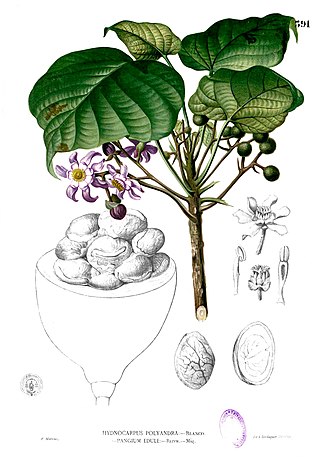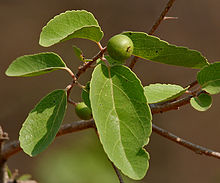
The Malpighiales comprise one of the largest orders of flowering plants, containing about 36 families and more than 16,000 species, about 7.8% of the eudicots. The order is very diverse, containing plants as different as the willow, violet, poinsettia, manchineel, rafflesia and coca plant, and are hard to recognize except with molecular phylogenetic evidence. It is not part of any of the classification systems based only on plant morphology. Molecular clock calculations estimate the origin of stem group Malpighiales at around 100 million years ago (Mya) and the origin of crown group Malpighiales at about 90 Mya.

The Salicaceae is the willow family of flowering plants. The traditional family included the willows, poplar, aspen, and cottonwoods. Genetic studies summarized by the Angiosperm Phylogeny Group (APG) have greatly expanded the circumscription of the family to contain 56 genera and about 1220 species, including the Scyphostegiaceae and many of the former Flacourtiaceae.

Phyllanthaceae is a family of flowering plants in the eudicot order Malpighiales. It is most closely related to the family Picrodendraceae.

The family Pandaceae consists of three genera that were formerly recognized in the Euphorbiaceae. Those are:

Achariaceae is a family of flowering plants consisting of 32-33 genera with about 155 species of tropical herbs, shrubs, and trees. The APG IV system has greatly expanded the scope of the family by including many genera previously classified in Flacourtiaceae. Molecular data strongly support the inclusion of this family in the order Malpighiales.

Samydaceae is a family of tropical and subtropical woody plants, its best known genus being Casearia. It has always been of uncertain placement, in the past usually being submerged in the family Flacourtiaceae.

Peridiscaceae is a family of flowering plants in the order Saxifragales. Four genera comprise this family: Medusandra, Soyauxia, Peridiscus, and Whittonia., with a total of 12 known species. It has a disjunct distribution, with Peridiscus occurring in Venezuela and northern Brazil, Whittonia in Guyana, Medusandra in Cameroon, and Soyauxia in tropical West Africa. Whittonia is possibly extinct, being known from only one specimen collected below Kaieteur Falls in Guyana. In 2006, archeologists attempted to rediscover it, however, it proved unsuccessful.
Dipentodon is a genus of flowering plants in the family Dipentodontaceae. Its only species, Dipentodon sinicus, is a small, deciduous tree native to southern China, northern Myanmar, and northern India. It has been little studied and until recently its affinities remained obscure.
Hasseltiopsis is a monotypic genus of flowering plants in the family Salicaceae. It consists of one species of trees: Hasseltiopsis dioica, which is native to Central America. Formerly placed in the heterogeneous family Flacourtiaceae, Hasseltiopsis is now classified in Salicaceae, along with close relatives Prockia, Pineda, Neosprucea, and Banara.

Calantica is a genus of flowering plants in the family Salicaceae. It contains 10 species of shrubs and trees endemic to Madagascar, seven of which are threatened. Calantica is closely related to the pantropical and diverse genus Homalium, from which it differs in having a superior ovary, instead of a semi-inferior ovary. The genus is also similar to Bivinia in its superior ovary but has numerous stamens and long spiciform inflorescences.
Scyphostegia borneensis is a species of shrub or small tree endemic to Borneo. This unusual plant is the only species in the genus Scyphostegia. In many taxonomic classifications the genus was placed in its own family, the Scyphostegiaceae. Analyses of DNA data indicated that the species is related to a group of species of the now defunct Flacourtiaceae, a group which is now placed in a broadly circumscribed Salicaceae.
Ahernia is a genus of a single species of trees in the willow family Salicaceae found in Hainan province of China and Luzon island of the Philippines. Previously it was treated in the family Flacourtiaceae or Achariaceae. Ahernia is closely related to the American genera Hasseltia, Macrothumia, and Pleuranthodendron, but differs in its axillary racemes and more numerous (10–15) petals. Ahernia glandulosa is found in low elevation primary forests and is known in the Tagalog language as butun or sanglai. It grows 8–15 m (26–49 ft) tall.
Euceraea is a genus of three species of shrubs and small trees in the willow family Salicaceae native to the Guiana Shield of northeastern South America. Previously it was treated in the family Flacourtiaceae but was moved along with its close relatives to the Salicaceae based on analyses of DNA data. Euceraea is closely related to the genera Casearia and Neoptychocarpus, but differs in its inflorescences of composite spikes. One species, Euceraea rheophytica, is a rheophyte.
Irenodendron is a genus of three species of shrubs and trees in the willow family Salicaceae native to northern South America. These species were previously treated as a section of the genus Laetia in the family Flacourtiaceae, but the genus Laetia and its relatives were moved to the Salicaceae based on analyses of DNA data. Irenodendron was later hypothesized to be more closely related to the genera Ryania, Trichostephanus, and Piparea due to the presence of an apically divided style, and wood with dark heartwood and large rays; it differs from those genera in having cup-shaped bracts under the flowers and in lacking staminodes.
Osmelia is a genus of flowering plants in the willow family, Salicaceae. Osmelia includes four species of trees native to Sri Lanka and Southeast Asia. Osmelia is closely related to the monotypic Pseudosmelia of Morotai and Halmahera of the Indonesian Maluku Islands and to the monotypic Ophiobotrys from west and west-central tropical Africa.
Zuelania guidonia is a species of shrub or tree native to the West Indies, Central America, and northern South America and is the only member of the genus Zuelania. Formerly classified in the Flacourtiaceae, phylogenetic analyses based on DNA data indicate that this species, along with its close relatives in Casearia, Samyda, Hecatostemon, and Laetia, are better placed in a broadly circumscribed Salicaceae. Zuelania differs from its close relatives in having a large, subsessile stigma.
Ophiobotrys zenkeri is a species of tree native to tropical Africa from Ivory Coast to Gabon and is the only member of the genus Ophiobotrys. Formerly classified in the Flacourtiaceae, phylogenetic analyses based on DNA data indicate that this species, along with its close relatives in the Asian genera Osmelia and Pseudosmelia, are better placed in a broadly circumscribed Salicaceae. Ophiobotrys differs from its close relatives in having 5 sepals, 5(-6) stamens, one divided style, and terminal inflorescences.

Macrothumia kuhlmannii is a species of trees native to Bahia, Espírito Santo, and Minas Gerais states of Brazil and is the only member of the genus Macrothumia. Formerly classified in the genus Banara in the family Flacourtiaceae, phylogenetic analyses based on DNA data indicate that this species, along with its close relatives in Ahernia, Hasseltia, and Pleuranthodendron are better placed in a broadly circumscribed Salicaceae. Macrothumia differs from its close relatives in having a congested fascicle- or umbel-like inflorescence and a large fruit. The genus name is derived from the Greek word μακροθυμία, which means long-suffering and enduring patience.
Tetrathylacium is a genus of two species of shrubs and small trees in the family Salicaceae native to the southern Central America and northern South America. Previously it was treated in the family Flacourtiaceae but was moved along with its close relatives to the Salicaceae based on analyses of DNA data. Tetrathylacium is rather unique in the Samydaceae in having tightly arranged panicles of spikes, four sepals and stamens, and non-arillate seeds. The stems are often inhabited by ants, and T. macrophyllum is suspected to have locust pollination.
Tisonia is a genus of flowering plants belonging to the family Salicaceae. It is also in the subfamily Salicoideae and tribe Saliceae.









